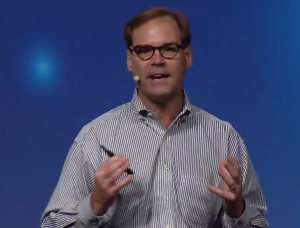
Rob Bearden Returns to Lead Cloudera’s Second Act

Rob Bearden was named CEO of Cloudera on January 13, 2020
When Cloudera ran into trouble last June following poor financial results, the board jettisoned senior leadership, including CEO Tom Reilly and Mike Olson, its chief strategy officer. Those moves would open up a path for Hortonworks co-founder Rob Bearden to return to the company that he had a hand in shaping. But with the Hadoop bubble popped, the question remains: Can Bearden succeed in resurrecting Cloudera in the new data age?
Cloudera last week announced the hiring of Bearden to be its full-time CEO, replacing interim CEO Marty Cole, who retired. According to chief marketing officer Mick Hollison, Cloudera would have hired Bearden last June if he was available. But Bearden has just taken the top job at Docker following the completion of the merger of Cloudera and Hortonworks, so he wasn’t available.
So Cloudera continued to search for a permanent CEO, and interviewed internally and externally for the right fit. When Docker’s restructuring was complete, and Cloudera still hadn’t named a permanent CEO, it wasn’t a tough call to offer the job to Bearden.
“When Rob was available, he was a hands-down winner, from the point of view of being a long-time industry veteran who knows an awful lot about open source,” Hollison says. “Obviously he has a long-standing relationship with or head of engineering, Arun Murthy, so he was just going to be the least disruptive and best qualified candidate to take on the job. Once he was willing to raise his hand again, the board kind of scooped him up quick.”
Bearden never ventured too far from the converged Cloudera-Hortonworks organization, as he never relinquished his seat on the board of directors. For the past three months, Bearden has been working closely on Cloudera’s and its new enterprise data strategy, which it unveiled late last year. Slotting Rob into the top job just made a lot of sense, Hollison says.
“It would be very hard tough to find somebody on resume that would stack up better than Rob did in in terms of quality,” he says.
Second Chances
The departure of Reilly and Olson marked an end of an era. The company’s stock, which is traded on the New York Stock Exchange under the ticker symbol CLDR, had lost over 44% of its market capitalization in June 2018 following the announcement of the disastrous second quarter results. Faced with lower-than-expected sales, the company was forced to lower its earnings estimate for the fiscal year, which angered Wall Street even more.
To make matters worse, Cloudera’s competitor, MapR Technologies, was going through its own financial drama that threatened to kill the company. MapR reportedly suffered from the same drop-off in subscription sales during the first part of the year that Cloudera had faced. Confronted with that sales slowdown, MapR’s investors cancelled a planned cash infusion, putting the once high-flying Santa Clara, California company on the brink of insolvency. Were it not for HPE swooping in to purchase the company’s assets, that’s likely what would have happened.
The whole series of events seemed to mark the end of Hadoop as a marketable platform. With momentum surging toward the pubic clouds and their modern S3 storage and container compute resources, why would anybody deploy a legacy platform like Hadoop, which does not allow users to scale compute and storage independently?
Interim CEO Cole, who was already Cloudera’s chairman, is credited with helping to stabilize the company during a period of turmoil. That included tightening the belt on business operations, as well as making tough choices about what kind of computer platform Cloudera would build going forward.
“Marty came in and did a terrific job of not just analyzing the company and the business as a whole, but as you probably saw, we got ourselves in a lot healthier position from that point forward in the business,” Hollison said. “We had the low point of the stock right around that same time as his departure. And we put together a couple of very good quarters in a row, the Street has rewarded us accordingly. In my book, Marty did a terrific job, but Marty was always considered to be the interim solution.”
The pressure now falls to Bearden to keep the puck moving forward. Early indications are that Bearden will not implement a major strategy change at Cloudera, but instead will focus on executing the current strategy that Cloudera has already established.
Cloudera’s New Cloud Strategy
Cloudera’s current strategy revolves around building a new type of platform, called an enterprise data cloud.
At first glance, Cloudera’s enterprise data cloud bears many similarities to the Hadoop distributions that it used to sell. In fact, they both share many of the same parts and pieces, including processing engines like Spark, Hive, and Kafka, and management tools like Ranger and Cloudera Manager.
But there are key differences, namely in the core storage and workload management technologies. Mostly gone are HDFS and YARN, two core components of Hadoop distributions for years. In their place are S3 storage and Kubernetes, which is what most public cloud vendors use for their big data processing platforms (which also are built on Hadoop).
Cloudera’s first entry into the enterprise data cloud category is the Cloudera Data Platform (CDP), which the company announced at Strata last fall. Today CDP is available on the Microsoft Azure and Amazon Web Services clouds, and it will be available on Google Cloud soon. It supports S3 compatible storage and Kubernetes on all these platforms (using ALDS on Azure).
On top of these CDP offerings, Cloudera sells point solutions for data warehousing, machine learning, and streaming analytics, with more on the way. A key selling point for CDP is its ability to centrally manage, secure, govern, and track the lineage of data, no matter where the data resides, via Cloudera’s Shared Data Experience (SDX) and its Control Plane.
In late 2019, Cloudera took the wraps off CDP Data Center edition, the first on-prem version of the enterprise data cloud. This offering retains YARN and HDFS. But big changes are on the horizon for Cloudera, which is looking to build on CDP with the next iteration of its on-prem enterprise data cloud offering.
“For customers who will continue to stay on premise with their deployment, we gave them the best of both worlds, offerings that run on-prem and brings the best projects together from what had been separate CDH and HDP platforms historically,” Hollison says. “That offering will ultimately manifest itself over the course of 2020 also in the delivery of our private cloud offering, which will be fully containerized, leveraging Kubnernes and leveraging OpenShift in particular.”
Bearden and Cloudera have a lot riding on the new private cloud offering, which is the next-gen product that will take Cloudera into 2021. The product represents the next step forward for Cloudera in its battle to help clients manage, store, and process huge amounts of data on premise and in the cloud.
“It will look architecturally a lot like we’ve done for CDP on the public cloud, but it will run on bare metal and run on containers on top of that bare metal environment,” Hollison says. “We are shooting for that to come out in the late spring/early summer window.”
A Boomerang for Elephants?
Hadoop distributors once had the big data market almost to itself. They had the momentum and they set the agenda. There was a lot of interest in consolidating many disparate and expensive databases into massive data lakes running atop Hadoop.
But as Hadoop distributions grew bigger and more complex, the cost advantages of Hadoop started to disappear (if they ever appeared for some customers in the first place) and today many companies (especially smaller one) are going straight to the cloud, where a lot of the engineering work has been done for them and the Hadoop distributions are simpler.
To hear Hollison tell it, Cloudera has learned this lesson about simplicity, and promises that future versions of the enterprise data cloud will not be overly complex. In fact, Cloudera hopes to pick up some customers who have been disaffected by the cloud and its high cost.
“We definitely see CDP playing a role in taking on a bunch of workloads and processing and storing the data wherever it can be done the most cost effectively,” he says. “We see that as a differential versus the big public cloud providers and in some instances versus the point solution providers as well. We do see a little bit of that boomerang effect, I guess I would say.”
Public clouds have been using “cloud native” technology like containers and Kubernetes to make Hadoop-based big data technology easier to manage, and all of their customers have benefited from that, if not the Hadoop distributors. But now it appears that Cloudera is set to use containers and Kubernetes to fight back against cloud hegemony.
“One of the wonderful things about the move to containerization, even for us and the way we deliver products, is it gets a little bit easier to have things integrated yet separated at the same time,” Hollison says. “In the move to the cloud, what project is delivering the service just become a lot less important. The end customer just cares about whether they’re getting a great service, or performing the streaming or the machine learning or whatever it is. They don’t care which three projects were required to deliver that service.”
Hadoop has changed quite a bit in the six months that Bearden was out of the game. Will he lead Cloudera to reclaim a larger share of the market in the face of stiff cloud competition? Only time will tell.
Related Items:
Cloudera Begins New Cloud Era with CDP Launch
How Cloudera Is Battling Shadow IT with CDP
Cloudera Commits to 100% Open Source
































